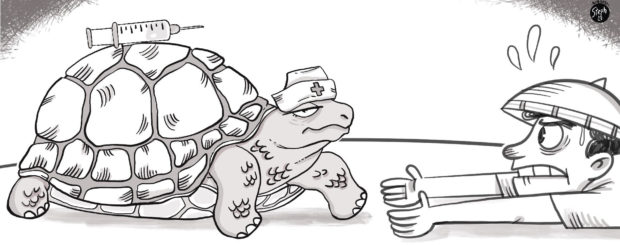Vaccine waste and delays

Considering the government’s already painfully slow COVID-19 vaccination pace, the prospect of having 2 million doses of the precious life-saving jabs expiring and going to waste would be a staggering development.
Dr. Anthony Leachon, former adviser to the Inter-Agency Task Force for the Management of Emerging Infectious Diseases (IATF), has raised the alarm that 1.5 million doses of AstraZeneca will be expiring next month. As it turns out, aside from the 1.5 million, there are 530,400 more doses that will expire by July. These are the 2,030,400 AstraZeneca doses that arrived in the country on May 8 under the World Health Organization-led COVAX facility.
“We are still at 40-60K vaccination per day. At this rate, we can never finish the AstraZeneca 1.5M stocks that will expire in June,’’ Leachon said in a tweet. He pointed out that local government units have not even finished administering the 3 million doses of the Chinese Sinovac vaccine. “We’re just half way through them. Sayang… super sayang.’’
Health Secretary Francisco Duque III has responded with smooth assurances that “We will make sure nothing will expire. It will all be jabbed.” Some 1.5 million doses would all be administered as first dose after the WHO promised that the shipment for the second dose will arrive on time, he said. The 500,000 doses would then be given as second doses to those who received the same vaccine brand last March and April.
But such assurances hardly inspire confidence given the government’s track record (e.g., the “ayuda” or cash assistance program to millions during the lockdowns that was marked by inordinate delays, disarray, and outright irregularities) and the current pace of the vaccination. Several officials have been vocal in expressing impatience over the trickle of allocations for their hard-hit localities.
“Hindi po mabagal, super bagal,’’ Manila Mayor Isko Moreno complained. The city received Sinovac vaccines in April at only 8,400 doses, he said. Other cities also stopped updating their online applications last month because of the lack of vaccines.
Health Undersecretary Myrna Cabotaje, who leads the national vaccine operations, reasoned out that “we cannot give everybody at the same time,’’ since only 50 to 70 percent are supposedly allocated for the National Capital Region and nearby provinces.
Other provinces have been begging for their share, too. Amid a surge of COVID-19 cases in her city, Zamboanga City Mayor Beng Climaco called on the national government to increase vaccine allocation for Region 9, noting that it has the second smallest vaccine allocation in the country.
Beyond meeting specific allocations, what is causing the perilous delay in distribution, to the point that vaccines already in the country’s hands face the possibility of expiring without being used?
An exasperated Leachon proposed that the government should just give the vaccines expiring in June to the private sector and let them do the job (a good idea). Sen. Nancy Binay, for her part, urged the administration to already open the vaccination to the A4 category, or the economic frontliners and government agencies. Cabotaje rejected this proposal, saying that under the terms of the COVAX facility, the AstraZeneca vaccines would only be used for the A1 (medical frontliners), A2 (senior citizens), and A3 (people with comorbidities) priority groups.
As of May 10, the country has received 7.57 million doses of different vaccines, according to National Task Force Against COVID-19 chief implementer Carlito Galvez. But as of May 12, the government has vaccinated only 1.96 million people with their first dose and 451,270 million with the second dose, barely a dent in the herd immunity target of 70 million Filipinos inoculated by end of 2021.
The daily vaccination rate is dismal. Data on May 4 showed that the seven-day average of people getting the vaccine nationwide was only at 36,491, a far shot from the target of 500,000 shots per day.
And yet while the country grapples with the slow arrival and dispersion of vaccines, it was reported that at least 348 vials of Sinovac vaccines in Makilala town, Cotabato City were damaged after being left for two days in a freezer without electricity.
“Nobody noticed that the freezer was not switched on,” Lito Cañedo, spokesperson for the IATF in Makilala said. It took another day for the health officials in the town to send the vials to the Department of Health for inspection. Then it took two days for the DOH to advise that the vaccines were no longer fit for use.
The proper handling of vaccines is another wrinkle in the already chaotic pandemic response; Cotabato’s unfortunate example could happen in other areas that are ill-equipped to meet proper storage protocols for the vaccines.
Delay, inefficiency, wastage: The vaccination phase is a make-or-break point for the country that the administration needs no reminding it cannot bungle, or it risks even bigger costs to public health and the economy.




















